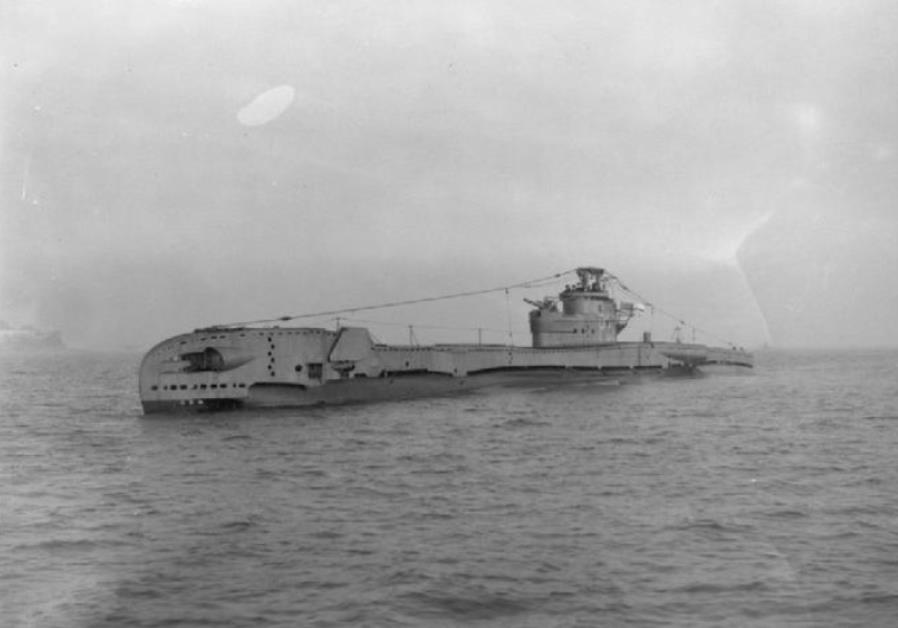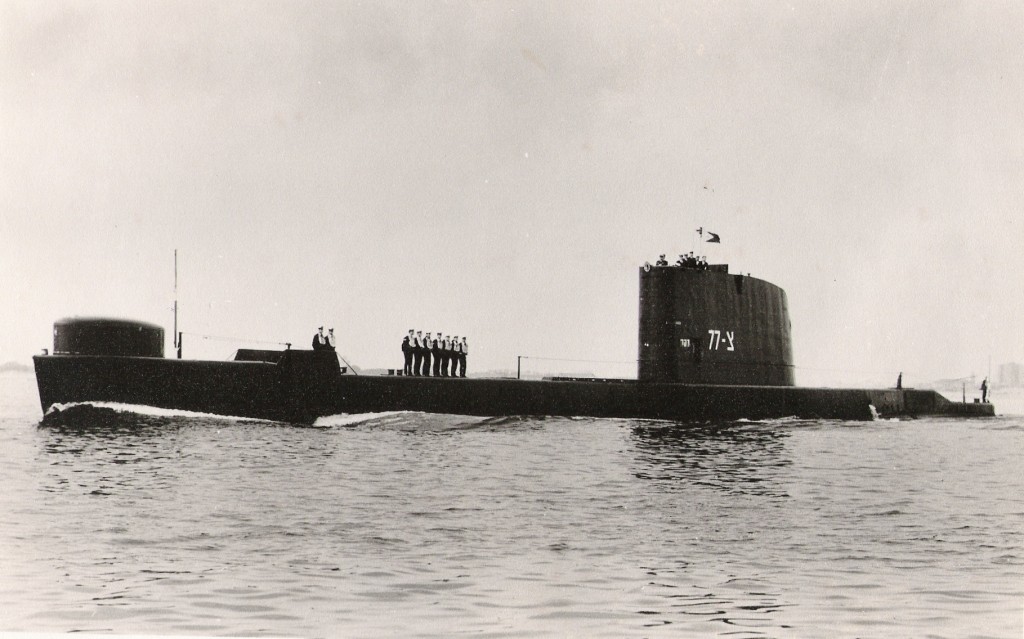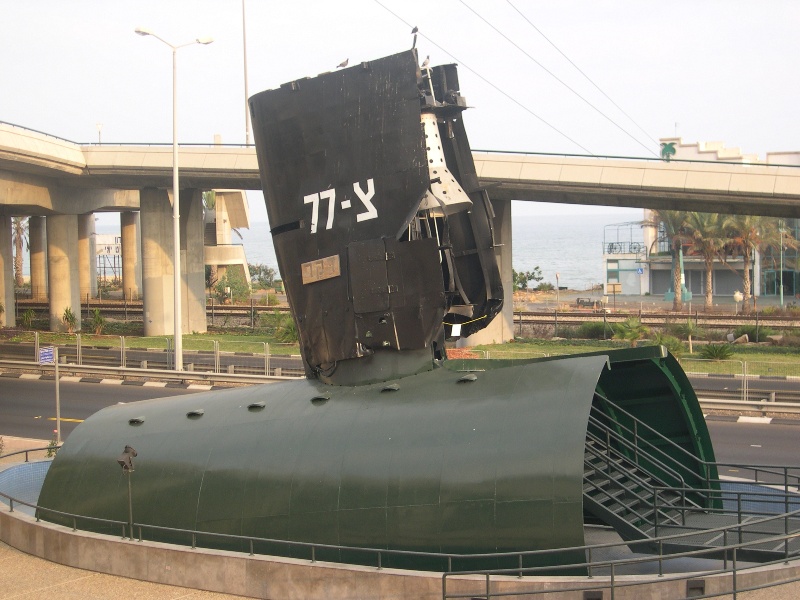Earlier this year (2019) while filling in time during heavy morning traffic in Haifa and passing the Naval Museum a tour guide related a story about the conning tower from a wrecked submarine which had been recovered some years previously. According to ancient Jewish custom those who are lost at sea outside the sight of land cannot be assumed to have died, as they might now be on some distant shore trying to return home. Accordingly, their wives could not remarry. Surely this interesting titbit called for further investigation!
HMS Totem was a T-class submarine built at the Royal Naval Dockyard at Devonport that entered service in the last few months of WWII. Totem carried a lucky mascot, an original totem pole which was presented to the ship by the North American Corwichan tribe on her first commission. This totem pole was proudly displayed in front of the conning tower when the ship was in port.
During her early career Totem also managed a visit ‘Down Under’ as in May 1945 when under command of Lieutenant Commander M. B. St. John, DSC, RN she proceeded from the Holy Loch to Gibraltar, through the Med and Suez to Trincomalee, arriving at Fremantle in July 1945 and later visiting Geelong and Melbourne. She then continued through South East Asia before returning home.

The Totem visit to Australia was the forerunner of the 1949 establishment in Sydney of the Royal Navy 4th Submarine Flotilla, initially comprising three T-class vessels. This flotilla, providing support to the RAN and RNZN, remained on the Australia Station until the RAN Oberon-class boats started arriving in 1967. HMS Trump, the last RN submarine, departed for home in 1969.
During a subsequent visit to Canada in 1950 the totem was stolen when Totem was berthed at Halifax, Nova Scotia. A legend had grown up that as long as the crew sailed with the totem the ship would come to no harm. To overcome these superstitions, the Canadian Naval Dockyard quickly made a replacement totem pole, and all was well.
The Cold War
Post war relationships between Great Britain, her Allies, and with the Soviet Union deteriorated resulting in a ‘Cold War Confrontation’. During this period a major operational function of the Royal Navy’s submarine fleet was to practise the interception of Soviet submarines leaving their bases in Northern Russia and prevent them from attacking British and Allied merchant vessels. To fulfil this role Totem was one of eight boats which were extensively modified, known as ‘Super T Conversions’, giving them higher speeds and quieter operational characteristics.
Totem was extensively modified at Chatham Naval Dockyard (which carried out all eight Super T-Conversions) between 1951 and 1953 which included lengthening the hull to accommodate additional electrical equipment, and radars and sonars were updated. The hull was streamlined by removing her deck gun and replacing the bridge fin with a taller structure that enclosed the periscopes and masts. In subsequent trials surface speeds of 20 knots and sub-surface speeds of 12 knots were achieved.
During 1955 Totem carried out ‘Operation Defiant’ a six-week patrol in the Barents Sea to gather signals intelligence on Soviet naval forces. Towards the end of the mission Totem was heavily depth charged, damaging the ship’s periscope. She dived to a depth of 280 feet (85 m) to evade the attacks and drifted into a minefield before escaping.


Totem refitted at Malta from December 1961 to January 1963 and then returned to home waters before joining the 1st Submarine Flotilla at Gosport. The submarine was purchased by Israel in 1965 along with her sisters the ex-HM Submarines Truncheon and Turpin, to form the nucleus of an Israeli naval submarine service. In preparation for transfer to Israel a modification had been made to the boat with an air lock to allow for underwater debarkation of naval commandos. While British engineers expressed concerns about the fitting of this air lock, as it added weight and increased stability problems, it still went ahead.
INS Dakar
At Portsmouth on 10 November 1967 the Star of David replaced the Union flag as Totem was commissioned as Israeli Naval Ship (INS) Dakar (in Hebrew meaning ‘swordfish’) under the command of Lieutenant Commander Ya’acov Ra’anan. Ra’anan, a professional submariner who completed the RN Perisher course in 1963, was highly regarded by his RN contemporaries and was a rising star of the Israeli Navy.
On 9 January 1968, Dakar departed Portsmouth for Haifa She was overloaded with sixty-nine aboard, well in excess of her normal crew of sixty. There was one important omission from this voyage; the lucky totem pole was missing, now secure in the Royal Naval Submarine Museum at Gosport.
On the morning of 15 January, Dakar put into Gibraltar, departing at midnight, and proceeded across the Mediterranean Sea underwater using her snorkel mast. Her last position report was at 0610 on 24 January, when she gave a location just east of Crete. There were three further routine messages which did not provide a position, the last being at 0002 on 25 January.
Despite an extensive search involving numerous friendly navies, no trace was found of the vessel. Her stern emergency marker buoy washed ashore on the coast of Khan Yunis, an Arab town southwest of Gaza, just over a year later, on 9 February 1969.
On 28 May 1999, after 31 years of searching, the Israel Navy announced that the remains of the submarine INS Dakar had been found. The wreck was located by the Nauticos Corporation, then under contract to the Israeli Government; Nauticos had previously found the wreck of Titanic. The wreck was located between the islands of Crete and Cyprus about 800 km from Israel at a depth of 9,800 feet (3,000 m). The precise cause of the accident is not known, but no emergency measures appear to have been carried out. It appears that the submarine dived suddenly and rapidly past her maximum depth limit and suffered a catastrophic hull rupture. The emergency buoy was released by the violence of the hull collapse, and washed ashore after drifting for a year.
On 11 October 2000 Dakar’s bridge and the forward edge of her sail were raised, and now stand as a memorial in the Clandestine Immigration and Naval Museum in Haifa.
The year 1968 was the worst peacetime period for fatal submarine accidents. In addition to Dakar another three vessels disappeared, the French Daphne-class submarine Minerve, the Soviet Golf-class submarine K-129 and the United States nuclear submarine Scorpion. All hands were lost in these four tragedies. Coincidentally 1968 announced the start of great cuts to the British defence forces with a resultant decline in morale.
Several theories were advanced as to the cause of the loss. These included collision and enemy action. If the latter had occurred, it was reasoned the crew may have been captured and held prisoner. Commander Brian Forbes, RN who captained Totem two years before she was sold to Israel, in an article published in The Jerusalem Post dated 23 September 2019 says: ‘The submarine had built-in-flaws which accounted for an above average loss rate of the T-class. Out of 50 vessels built, 18 sank1’.
Rabbinical authorities had to solve complicated problems of Jewish law before the wives of the crew member could be officially declared widows. In March 1981 the Chief Rabbi, Shlomo Goren, accepted the findings of the naval board of inquiry that when the vessel foundered all hands perished. In his report he decreed that under Jewish law 16 wives of the crew members were now free to remarry.
Should any of our readers have visited the Israeli Naval Museum we should be pleased to hear further on this fascinating historical story.
Note:
- A total of 53 T-class vessels were built. These were constructed in three groups. Group One: Fifteen pre-war boats with only six surviving. Group Two: Seven boats were built early in the war and only two survived. Group Three: Thirty-one built late in the war and post war, of which only three were lost, which included Totem/Dakar.




